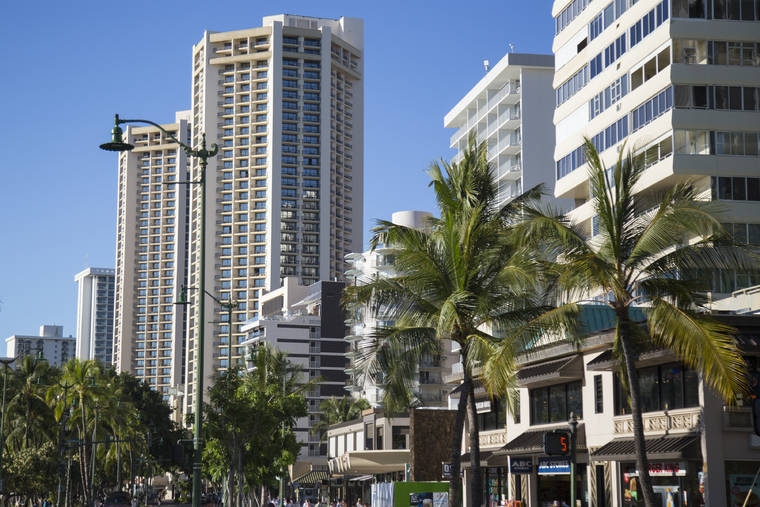Hawaii’s visitor industry is known for its aloha — but this week hoteliers and other members are learning to be less welcoming to sex traffickers whose $100 billion industry casts a dark shadow on this paradise.
“The threat is significant. It cannot be overstated. If you own or work for a hotel, there is human trafficking happening in your hotel — period, end of story,” said John Tobon, acting special agent in charge for Homeland Security Investigations Honolulu.
Tobon was one of a half-dozen or so speakers who participated Monday in the first Hawaii Tourism Authority-funded sex trafficking symposium, which was put on in partnership with the Hawaii Tourism and Lodging Association and Ho‘ola na Pua, a Hawaii nonprofit dedicated to combating sex trafficking. HTA is providing $50,000 for the training, which will be held on Maui today, Hawaii island on Wednesday and on Kauai on Thursday.
Hotels across the nation have long been top venues for traffickers, who typically either purchase rooms for illicit purposes or send prostitutes to clients who are staying in hotels. Recently there’s been greater recognition among law enforcement agencies and their partners that it’s hard to fight sex trafficking without visitor industry cooperation. Hotels are especially important since each touch point with a sex trafficking victim offers a chance to stop sexual exploitation or catch a trafficker.
For some in Hawaii, the disappearance of the parade of street walkers that once teetered down Kalakaua Avenue in their sky-high Lucite heels has created a false lull. But experts at the symposium said the state’s faraway geography and its high percentage of tourists and military put it at high risk for such crimes. And they say it’s only going to get worse if tourism managers and workers can’t recognize the problem, which in Hawaii often involves youngsters, who on average start at age 14.
Also, the language in Hawaii’s first sex trafficking law, which was passed in 2016 and mirrors nationwide standards, bans someone from advancing or profiting from the prostitution of a minor — potentially making businesses that don’t stop sex trafficking liable to the victims. Mar Brettman, president of Businesses Ending Slavery and Trafficking, said that a California tourism official told her that there are as many as 25 lawsuits brought by victims, including a 10-year-old girl, against hotels that didn’t protect them.
“Hotels are now saying not only is this the right thing to do for our community, this is the right thing to do for our business,” Brettman said.
There’s a lot at stake if the problem isn’t managed by Hawaii’s visitor industry, which last year hosted nearly 10 million visitors and brought nearly $18 billion into the state. And solving the problem is likely to grow more challenging as advances in digital marketing and social media continue to keep victims of sex traffickers off the streets. Check-in apps and other online programs that allow hotel guests to bypass the traditional front desk also have made it more difficult for hotels to detect sex traffickers who rely on legitimate businesses like hotels, airlines and other types of transportation businesses.
“We realize that the human traffickers typically operate invisibly throughout our hotels, and if we do not know what to look for, they will continue to operate invisibly,” said Trevor Bracher, complex director of human resources for Marriott’s Waikiki Complex. “But with the power of understanding, through the power of education, through the power of the training and awareness, they are no longer invisible, and we will continue to find where they are and report their whereabouts.”
Experts said hotels and other tourism venues have a big role to play in fighting sex trafficking networks, especially since the crimes here are notoriously underreported and often unrecognized. Tammy Bitanga, Ho‘ola na Pua’s community advocacy coordinator, is among those trying to change that. Bitanga knows Hawaii has a sex trafficking problem because as a youth she lived it firsthand.
“When I was 15 did you see me because I was running around out here in Waikiki?” Bitanga said. “Through foster care I meet somebody who was out working the streets of Waikiki, and she was under pimp control and it just seemed like a good idea. I was 15 years old so why not, right? Today we know why not.”
Hawaii Police Department spokeswoman Michelle Yu said the department “is committed to investigating all forms of human trafficking and will continue to work with federal and state law enforcement to bring perpetrators to justice.”
But in 2019 thus far, the HPD’s Morals Detail had opened only 48 cases under HRS Section 712-1200, prostitution and promoting prostitution, as well as two cases of sex trafficking. In 2018 the detail opened 66 cases involving prostitution and one case of sex trafficking.
Elaine McCartin, Polaris Project’s corporate partnership and training manager, said Hawaii’s National Human Trafficking Hotline statistics also are low — likely a sign that there’s not enough awareness of human trafficking or the national hotline. In 2017 the hotline statistics identified 27 Hawaii victims, 10 traffickers and six trafficking businesses, McCartin said.
McCartin urged Hawaii’s visitor industry to begin using the hotline, which provides immediate law enforcement and social resources to businesses working to combat sex trafficking as well as victims.
Mufi Hanneman, HLTA president and CEO, said he’ll work with other industry leaders to get the message out that it’s not enough to just call 911. When it comes to sex trafficking, Hannemann advocates bringing in the entire cavalry.
“It’s indecent, it’s illegal, it’s immoral and we need to rule it out especially when it comes to kids as young as 12 or 14 being involved,” he said.
Signs of human trafficking
>> An individual shows signs of fear, anxiety, tension, submission, and/or nervousness.
>> An individual exhibits evidence of verbal threats, emotional abuse, being treated in a demeaning manner.
>> An individual shows signs of malnutrition, poor hygiene, fatigue, sleep deprivation, untreated injuries, unusual behavior.
>> An individual lacks freedom of movement.
>> An individual avoids eye contact and interaction with others.
>> An individual has no control over or possession of money or ID.
>> An individual dresses inappropriately for their age or has poor quality clothing compared with others in their party.
>> An individual has few or no personal items such as luggage or other bags.
>> An individual appears to be with a significantly older “boyfriend” or in the company of older males.
>> A group of girls appears to be traveling with an older female or male.
>> A group of males or females have identical tattoos or brands in similar locations.
What to do
>> Don’t confront the trafficker directly or alert the victim to your suspicions.
>> Call 911 for emergencies.
>> Follow corporate protocol.
>> Call the National Human Trafficking Resource Center hotline at 888-373-7888, or text “BeFree” or Live Chat at humantrafficking hotline.org.
Source: Blue Campaign




